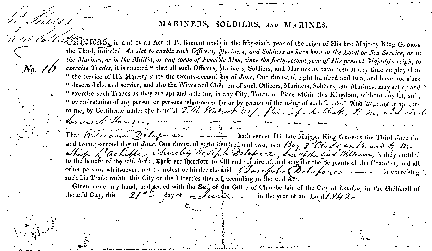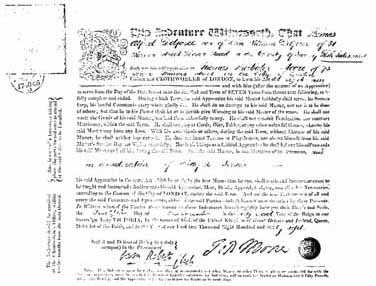 |
Patrick Delaforce & Ken Baldry'The Delaforce Family History' - Chapter 11
|
Chapter 11
The Money Men and the London Guilds and Trades
|
Apprenticeship was one of the principal means of learning and gaining admission in medieval times to a trade or profession. Guilds of traders and craftsmen originated in the early Middle Ages both as social institutions and as a means of regulating admission to trades and crafts, and maintaining standards of workmanship and trading In the 16th and 17th centuries the power of the Guilds was considerable, but started to wane during the 18th and by the 19th had virtually disappeared. By 1900 in the City of London there were still 77 livery companies. Many Delaforces belonged to the Silkweavers Guild as shown in the next chapter. The Freedom of the Guild was obtained in three ways:-
The rules of behaviour between Master and Apprentice were clearly spelt out as this extract from Indenture of apprenticeship shows "during which term the said apprentice his said Master faithfully shall serve - his secrets keep - and his lawful commands gladly do. He shall do no damage to his said Master, nor see it done by others, but that he, to his power shall hinder, or forthwith give warning to his said Master of the same. He shall not commit fornication, nor contract matrimony within the said terms. He shall not play cards, dice, tables, nor any other unlawful games, whereby His said Master may have any loss. With his own goods or others during the said term, without licence of his said Master, he shall neither buy nor sell. He shall not haunt taverns, nor playhouses, nor absent himself from his said Masters service day or night unlawfully, but in all things, as a faithful Apprentice, he shall behave himself towards his said Master, and all his, during the said term. And the said Master his said Apprentice in the same art and mystery which he useth, by the best means that he can, shall teach and instruct, or cause to be taught and instructed". The first recorded Delaforce Guild members were three or four Master Cutlers in the period 1274-1310 with a Raymond, William and a John classed as 'Cotelers' or 'taillandiers' and in 1288 when Peter de Fors was a Master to John atte Gate for 70s. In Dowgate ward in London. Peter and his brothers were merchants of wine from Cahors and leather shoes from Spain. Later a long but intermittent line of Goldsmiths, Silversmiths, Lombard bankers, Pawnbrokers and Stockbrokers was originated by Pierre de la Fosse/Force, elder son of Sir Bernard (1472-1523) who was a Goldsmith of Faversham, Kent. As Peter Force he left a will at Canterbury, and paid taxes for 3 years. James Le Forsey/De La Fore/Fosse', a 'Lombardes man' of 1551 in London, in St. Olaves, Hart Street was Pierres grandson or grand-nephew. Bernard Deforse, a 'Sylversmith' of St. Katherines Free Church, near St. Helens Bishopsgate, 1540-1613, was a grandson or grand-nephew of Peter Force. In 1583 John Desfort, 'Duch', was a Goldsmith of Aldersgate. Edward Delves or Force, the Goldsmith at the Mermaid in Lombard St. 1570-1638, who married Maria Balser in 1592, was a great grand-son of Pierre/Peter. Edward Deffors 1590-1651, who died in St. James, Clerkenwell, may have continued his father, Edward's, business. Oliver, his son, died in 1631. The "Golden Ball" shop existed in Winchester Street, off Broad Street in 1673, which John owned in 1740 or earlier. Then comes a long gap of traceable activity until John Delaforce 1702-1779, his son John, his grandson Samuel, his great grandson Samuel who were Pawnbrokers, Stockbrokers and Brokers (perhaps of commodities) of Bishopsgate, Norton Folgate and Southwark, until well into the 19th century. John Delaforce 1729-1788 was a Member of the City List of Brokers on 2nd July 1782, in partnership with Joseph Bond, Citizen and Blacksmith, with each paying a £500 Bond (Ref. CCRO Fr 163(4). (More on this link). His son Samuel 1750-1805 also became a Stockbroker (Book Q3) on the London Stock Exchange in 1793 in partnership with Samuel Robinson, Auctioneer, of Christchurch, Surrey. Both paid a Bond of £500. Samuel's son Samuel, baptised 1773 was also a Broker and a Pawnbroker. Tailors
It has not been possible to trace continuity of this trade. None of the Delaforces were members of the Merchant Tailors Guild. CooksThe original records in the London Guildhall show:
Other Guild members included: Samuel Delaforce 1749-1805 was Apprenticed 5th July 1763 to John Speere and later Mr Bunyard, and on 4th September 1770 was made a Freeman of the Carpenters Guild. The church registers showed him as a Cabinet Maker. His son Samuel became a member of the Carpenters Guild in 1821. James Fawcey(?) 1722 was admitted to the Framework Knitters Guild. John Delaforce 1729-1788 became a Freeman 21st November 1749 of the Musicians Guild, described in church registers as a Musicianer. Daniel Delaforce baptised 1751 was app. March 1765 to Stephen Skinner and made Free August 1775 as a Barber. His father John paid the £5 fee. John Delafors baptised 1744 was made Freeman (4618d.) 2nd September 1766 as a Spectaclemaker. Joseph Delaforce baptised 1783, app. 1st November 1797, made Free February 1805 as a Clothworker. The fee of £2 was paid by Langbourne Ward Charity School. He was son of Thomas Delaforce, weaver of Mile End New Town. The Guildhall library has a superb collection of early Guild manuscripts. The City of London Freedom Registers in the office of the Chamberlain of London also have an excellent series of records of Guild memberships from 1784. 
Freedom of the City of London for Joseph Delaforce, 1842
Indenture of Thomas Alfred Delaforce, lighterman 1868 |
|
Contact: Ken Baldry for more information, 17 Gerrard Road, Islington, London N1 8AY +44(0)20 7359 6294 but best to e-mail him |
